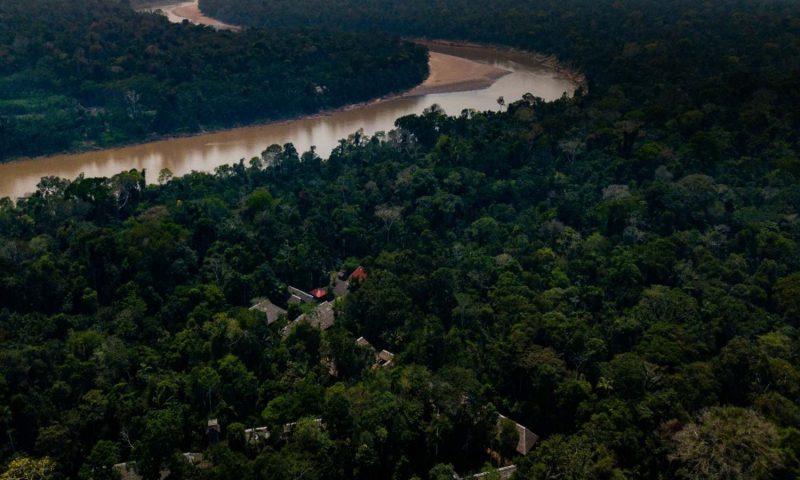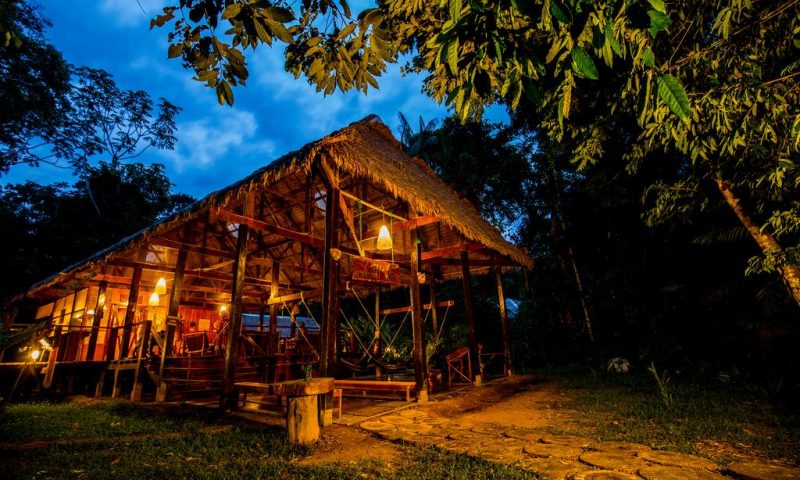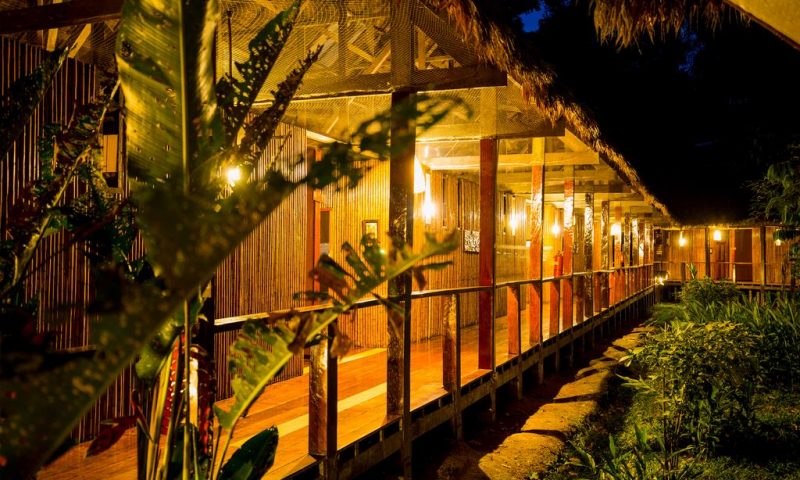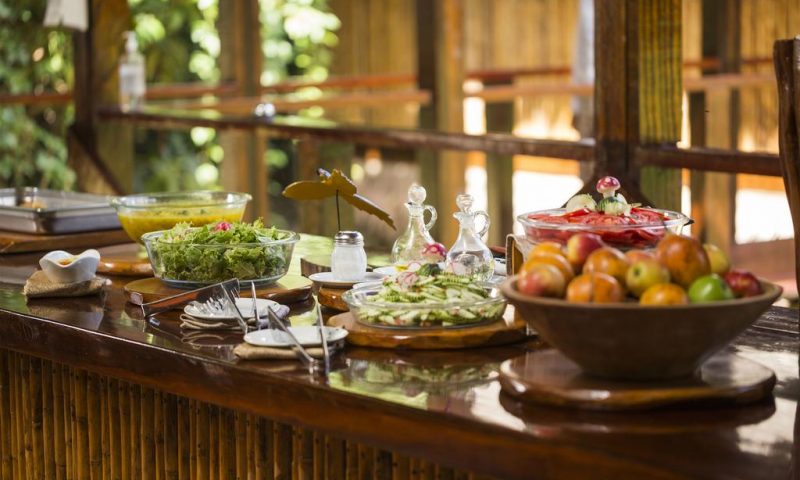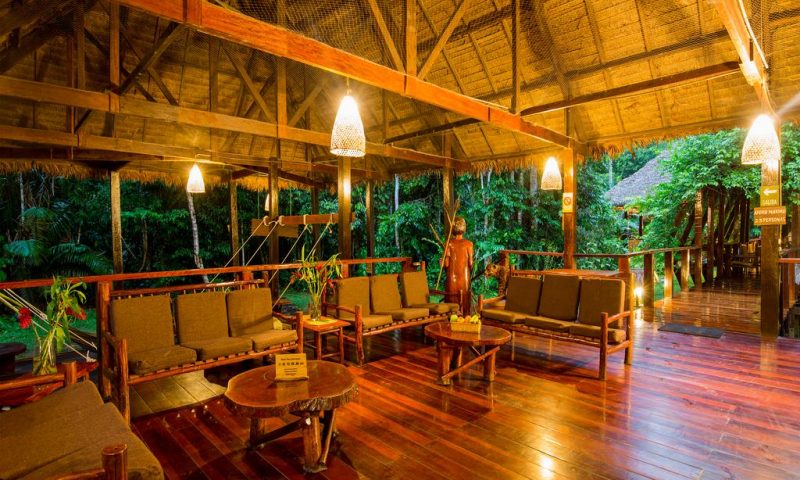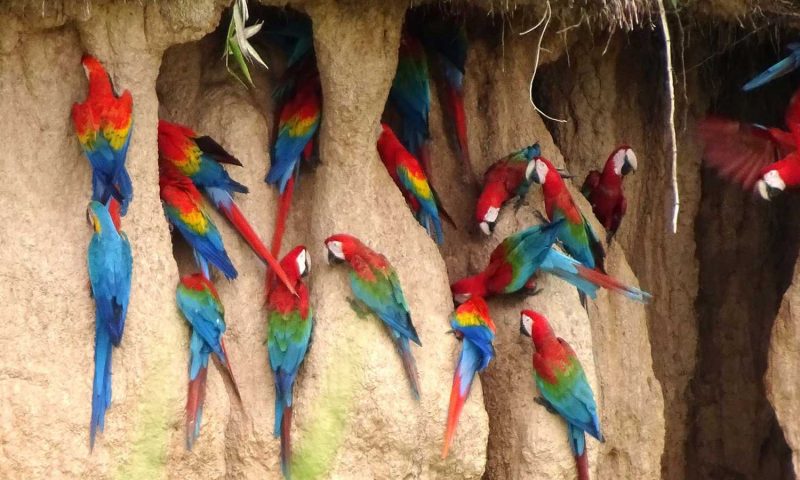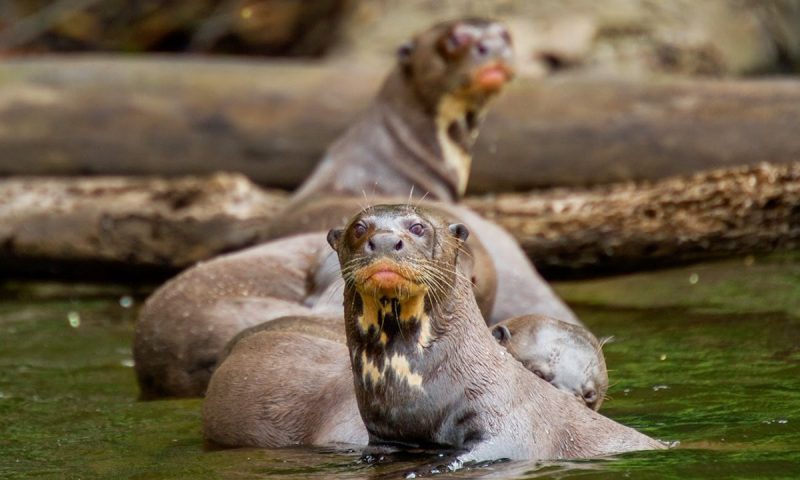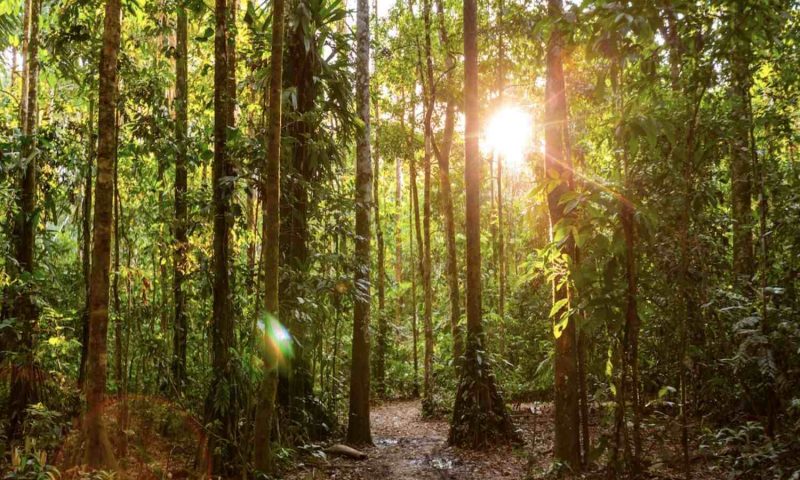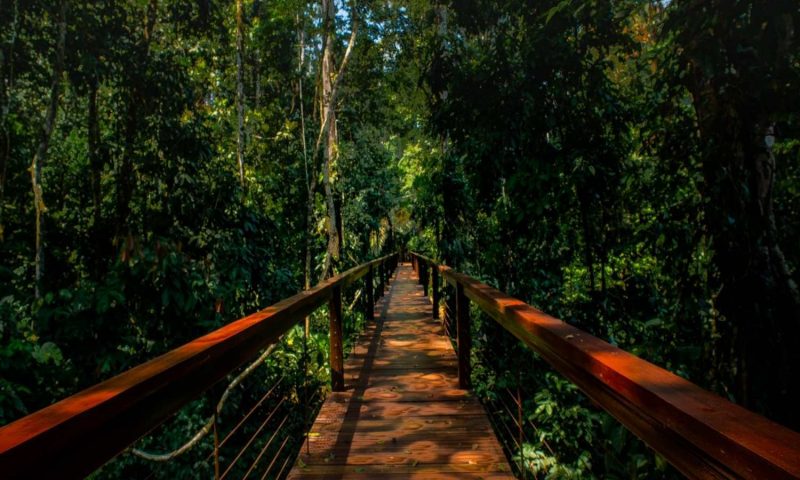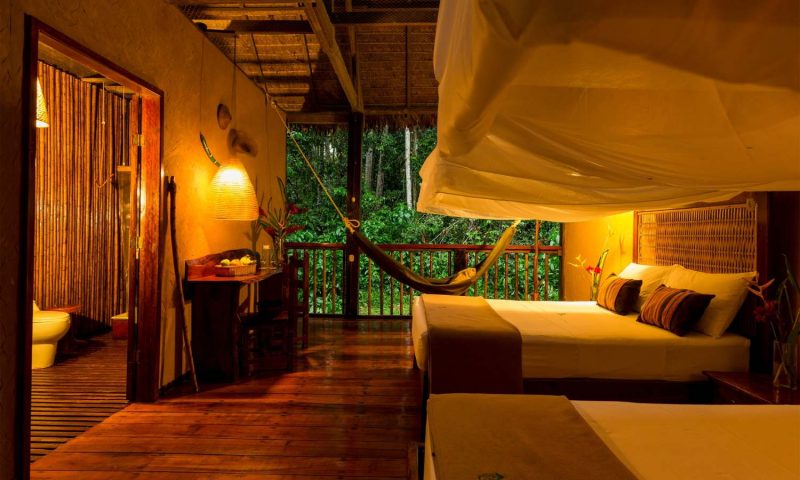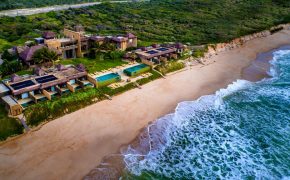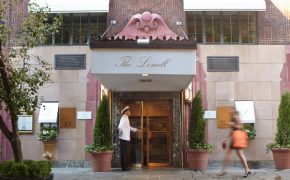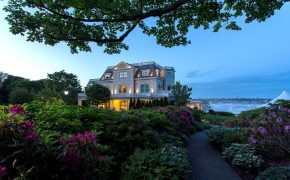Within the pristine Amazon Rainforest, our Posada Amazonas lodge connects you to the natural and cultural wonders of the Tambopata jungle.
When researching for a hotel in Puerto Maldonado, this jungle ecolodge offers a unique set of activities with ample opportunities to observe wildlife and to discover ancient indigenous heritage where you can choose letting create your own personal adventure.
- Posada Amazonas is owned by the Ese Eja indigenous community of nearby Infierno, Peru, and managed in partnership with Rainforest Expeditions.
- Our 42 meter (137 foot) Canopy Tower offers spectacular views of the vast expanses of rainforest around the lodge.
- We visit Lake Tres Chimbadas on a catamaran, exploring in search of the resident Giant River Otter family, along with other wildlife like Hoatzins and Black Caimans in an exclusive experience.
To begin your rainforest Amazon tour, you take a quick plane trip from Lima (1 hour and a half) or Cuzco ( 30 minutes) to the city of Puerto Maldonado, Southeast of Peru. After we meet you at the airport, we’ll take you to our office 5 minutes away to refresh yourself and prepare for the journey to the lodge.
After a 1-hour road trip, we will take a tranquil 1-hour boating through the Tambopata River to immerse ourselves inside the heart of the private communal reserve of the Ese Eja Native Community of Infierno.
Rooms
Enjoy the open wall facing the Amazon rainforest and awake with jungle sounds in the morning. Our room rates include all land and river transportation to/from Puerto Maldonado to the lodge through our fixed departure land and river transportation, guided activities in small groups, all meals, and accommodation.
We have electricity in common areas three times per day: From 6hrs to 8hrs – From 12hrs to 14hrs – From 17hrs to 22hrs (Referential time). You will find WIFI at our lodges. Please note internet connection might vary on weather conditions and the number of guests
CANOPY TOWER
As you crane your neck to see the top of the Canopy Tower, it doesn’t seem that high up. But when you ascend the staircase and reach the top platform, you realize just how high you are. Freed from the dense vegetation of the forest, you can see all the way to the horizon, framed by an endless sea of treetops.
Most rainforest life is actually in the trees’ highest reaches: the canopy. While hiking through the jungle, the trees can rise over 60 meters (180 feet) above the ground, making you feel like you’re in an immense temple to nature.
But the Canopy Tower is another story entirely. Reaching above the treetops, we’ve built several safe, sturdy towers that give you a bird’s eye view of the rainforest. Our guides will lead you on a hike to the tower and help out as you climb its steps at your own pace.
Finally, you reach the top. There, you’ll be able to see miles of pristine forest stretching in every direction. Because animals are most active in the canopy, you’ll have incredible chances to see wildlife.
In this unforgettable experience, you’ll be awed by the intimate views of treetop animals, paired with the sweeping panorama of the jungle.
Get a Revolutionary Perspective on the Rainforest: After hiking on our winding jungle trails, you’ve already marveled at the huge trunks of rainforest trees. But rising to the canopy gives you an entirely different appreciation of these miraculous Amazon giants.
Centuries-old Brazil Nut trees, Acacias, Ceibas, and Ironwoods tower above the rest. Seeing these ancient trees is an experience you won’t soon forget.
See Astounding Treetop Wildlife: From the upper levels of the tower, your expert guide will scan for monkeys, Toucans, and other canopy-dwellers, which you’ll get to spot with a powerful scope.
Flocks of screeching Parrots and Parakeets soar close to the tower. Macaws also fly overhead, occasionally perching in nearby trees. Down below, exotic birds like Jacamars and Trogons sit, as mixed flocks of glittering Tanagers and Honeycreepers flutter through the greenery.
TRAVEL TO TAMBOPATA
This place harbors some of the wildest, least impacted habitats in the Amazon and the world. It is on the shortlist of “must-see” nature destinations in Peru and South America. Because of that we highly recommend you to travel to Tambopata.
Planning travel to Tambopata however, can be confusing. There is a lot of information on the internet about the destination, the lodges, and the tour operators. There are also many synonyms. Tambopata is a river, a province, and a national reserve.
It is reached through the gateway city of Puerto Maldonado and is directly adjacent to another great nature destination: the Bahuaja Sonene National Park. And, Tambopata shares visits with two other good destinations of the Peruvian Amazon: Manu and Iquitos. We will help you to understand all of it on this one page.
What is Tambopata?
Most people know Tambopata because of the Tambopata River and the huge Tambopata National Reserve that protects it. Tambopata is also one of the provinces of the Amazonian state of Madre de Dios (or “Mother of God”). We will, however, refer to the Tambopata National Reserve when we say “Tambopata” in this article.
Tambopata is a Quechua word, with Tambo meaning a structure or building, and pata meaning “high place.” The name comes from the Tambopata River, which begins in the highland Puno area near Lake Titicaca, and flows down towards this part of the country.
Tambopata’s biggest city is Puerto Maldonado, and that’s where most travelers fly to begin their jungle trip. Best of all, Tambopata is right next to several other rainforest reserves, including Bahuaja Sonene National Park.
What can I see in Tambopata?
When travelers come to Tambopata, they usually visit the Tambopata National Reserve and the areas around it. The reserve is enormous, protecting 274,690 hectares (1,061 square miles) of pristine wilderness.
To give you a sense of just how big that is, it’s about the size of the iconic Yosemite National Park in the United States. It contains great habitat diversity, from old-growth Amazonian rainforest to bamboo groves, from floodplains and wetlands to oxbow lakes to palm swamps.
Thanks to this variety of well-preserved habitats, Tambopata is one of the most biodiverse areas in the world. There are more than 1,000 species of butterflies, 100 species of mammals, 600 species of birds, and hundreds of species of trees and plants!
During your visit, you’re likely to see Monkeys, Parrots and Macaws, Caiman, Toucans, and much more.
Who lives in Tambopata?
Tambopata is the home of the Ese Eja People, an indigenous nation that has lived in the rainforest region for many years. “Ese Eja” literally means people.
There are three Ese Eja native communities around the Tambopata National Reserve: Infierno (about 200 families), Palma Real (about 50 families), and Sonene (about 20 families).
Rainforest Expeditions has collaborated with the Ese Eja community in Infierno for over two decades, working on nature and heritage preservation projects together, and jointly running the Posada Amazonas lodge.
Traditionally, the Ese Eja are hunters, fishermen, and farmers, although many families now have commercial or tourism connections as well. Today, tourism and brazil nut gathering (a sustainable type of food production) are the two principal economic activities within the Tambopata National Reserve.
In the areas around the reserve, farming tropical foods like papaya, pineapple, and cacao is more common. While tourism has grown in Tambopata in recent years, the region and reserve are so large that it’s never crowded, providing an intimate, still deeply wild experience.
Tambopata is now one of the principal tourism destinations in Peru but because of its huge size, it is not crowded. If you like or love nature then Tambopata is for you.
How to Get to Tambopata
To get to the Tambopata National Reserve you first need to go to Puerto Maldonado. Puerto Maldonado is the gateway city to the reserve and the capital of Madre de Dios. There are daily incoming flights to Puerto Maldonado. These flights arrive from Lima or Cuzco, at least three times a day.
The flights from Lima depart from Jorge Chavez airport’s domestic flight terminal. The trip takes about 3 hours and most flights stop in Cuzco before continuing to Puerto Maldonado. Flights from Cusco depart from the domestic terminal of the Velasco Astete airport, and the trip takes around forty-five minutes.
In Puerto Maldonado, Rainforest Expeditions and most lodge and tour operator companies will be waiting for you at the airport arrivals terminal. From there, you hop on a bus for a quick stop to headquarters before continuing on to the river ports.
Once at the port, you will board on boats to continue to the lodges. Lodges are 1 to 4 hours away by boat from the port. Keep in mind: the longer you go, the better the wildlife.
Boat schedules are designed to meet incoming and departing flights but you should not arrive after 1500 because then you may have to travel by boat in the dark, before getting to your lodge. Boat rides are great. You will probably see capybara and caiman on the Tambopata River and with lots of luck a jaguar!
When to travel to Tambopata?
Tambopata is slightly seasonal – although nothing like the temperate zone. Although it can rain at any time of the year, Tambopata is drier from April to November, when the rains stop and start, respectively.
The rainiest months are January and February, but even then you are rarely rained out. The pros of visiting in the dry season are that there is very little chance your activities will be affected by rain.
The pros of visiting in the rainy season are that macaws are more active on the clay licks and they are nesting. If you are into macaws, come between December and February when nesting season is in full fledge.
What to do in Tambopata?
This is a key question- no one goes to the Amazon to stay inside the lodge. The vast majority of lodge and tour operators include activities in their per night fees. In Tambopata, you don´t wake up and choose a path to take (that is for Paris!).
Nor do you sit back and do nothing (that is for Cancun!). Nor do you have a single trail you follow to reach a destination (that is for the Inka Trail!). Every day, in Tambopata, your operator offers a variety of curated activities you can choose from, and most of them should be included in your fee.
Biodiversity of Tambopata
The lowland forests and tropical savannahs of Tambopata are some of the most biodiverse areas on the globe.
- Birds: 670 bird species have been identified, including the Harpy Eagle, a large, rare raptor that preys on monkeys and sloths, the strange Hoatzin, and eight macaw species (six of which can be seen at the Tambopata Research Center clay lick).
- Mammals: 200 species, including healthy populations of Jaguar, Giant Anteater, Amazonian Tapir, and, in the savannah habitats of the Rio Heath, the Maned Wolf.
- Reptiles and Amphibians: 210 species, including several species of tree frogs, the colorful Tambopata Poison Frog, and the beautiful Rainbow Boa.
- Insects and other arthropods: The number of species of insects and spiders that live in the rainforests of Tambopata number in the thousands. Many are expected to be species unknown to science.
- Trees and plants: Over 10,000 species of plants have been identified in Tambopata, Peru, making it one of the highest areas for plant diversity on the planet. A few of the more noteworthy plants are the Brazil Nut Tree, the huge Ceiba, and quick-growing Balsa trees.
TAMBOPATA NATIONAL RESERVE
The Tambopata National Reserve is one of the true remaining jewels of the Amazon Rainforest. It’s a must-visit destination for Peru travelers and nature lovers from around the globe. Here, we give you some background on the Reserve’s history, ecology, and diversity.
What is the Tambopata National Reserve?
The Tambopata National Reserve is 274,690 hectares (1,061 square miles) of preserved land in Southeastern Peru. The Reserve has many diverse habitats, including lowland Amazon rainforest, riverine forest, and oxbow lakes.
It’s crossed by three rivers: the Malinowski, the Tambopata, and the Madre de Dios rivers. Because of the Reserve’s protected status and secluded location, it’s incredibly biodiverse.
The reserve plays host to over 1,000 species of butterflies, 100 species of mammals, around 600 species of birds, and hundreds of species of trees and plants. In fact, this reserve and surrounding region are one of the most biodiverse places on the planet!
The Reserve and the surrounding area also have their own cultural background. Originally home to the Ese Eja People, many indigenous families still make their homes in the buffer zone of the Reserve itself.
Within the boundaries of the reserve, the only human settlements are a few ranger stations, and our Tambopata Research Center lodge, known as the TRC.
The TRC is in the Reserve because the lodge was established before the area received National Reserve status in 1996. This actually makes the TRC the most remote lodge in South America!
How Was the Tambopata National Reserve Created?
Starting in 1990, several biologists and conservationists began lobbying to protect the Tambopata area from development. They were passionate about preserving this area because it was (and is) one of the last remaining and largest areas of pristine rainforest.
Specifically, Tambopata is one of the very few areas containing lowland and foothill rainforests and connects to cloud forests at higher elevations and wet savannahs! Even more, very few people were living in Tambopata’s most remote areas.
Conservationists realized that the region could act as a major corridor between Manu National Park and Bolivia’s jungles. The area also harbored healthy populations of Tapirs, Jaguars and other felines, Giant Otters, Harpy Eagles, many types of Macaws, and other animals that had disappeared from other parts of Amazonia.
At first, the area that includes the present-day Tambopata National Reserve and the nearby Bahuaja Sonene National Park was known as the “Tambopata-Candamo Reserved Zone,” as an earlier form of protection.
While “reserved zone” status did afford the area some protection, it left the window open for changes in land use, so the area was still at risk.
Conservation organizations carried out further studies to help give the area a more permanent protected status, which showed that protecting the region was crucially important for biodiversity and could work with local cultures.
Those studies helped build a strong case to change Tambopata’s status from a “reserved zone” to a “national reserve,” a more official, permanent protection. The Tambopata National Reserve was born!
